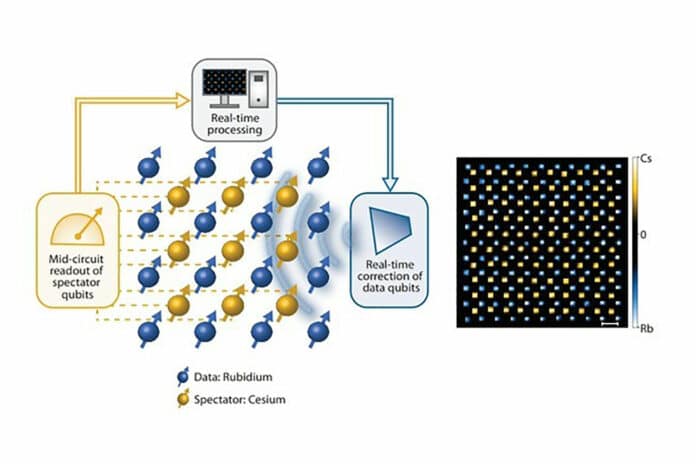Despite their immense promise to solve new problems, today’s quantum computers are inherently prone to error. Scaling up invariably error-prone quantum processors is a formidable challenge. Although quantum error correction ultimately promises fault-tolerant operation, the required qubit overhead and error thresholds are daunting.
Now, scientists from the Pritzker School of Molecular Engineering (PME) at the University of Chicago have created a brand-new technique to continuously monitor the noise surrounding a quantum system and modify the qubits in real-time to reduce inaccuracy.
Their approach mainly relies on spectator qubits: a set of qubits embedded in the computer to measure outside noise rather than store data. The noise in crucial data-processing qubits can be eliminated using the information obtained from such qubits.
Asst. Prof. Hannes Bernien, who led the research, said, “With this approach, we can very robustly improve the quality of the data qubits. I see this as being very important in the context of quantum computing and quantum simulation.”
Theoretical physicists had previously suggested spectator qubits, which may be integrated into a quantum computer but don’t store any necessary data. The spectator qubits would work like the microphone in a pair of noise-canceling headphones, monitoring changes in the surrounding environment. Naturally, a microphone can only detect sound waves, whereas the proposed spectator qubits would react to all environmental changes that may affect qubits.
Bernien’s team aimed to show how this theoretical idea might be applied to reduce noise in a neutral atom quantum array, which was their preferred quantum computer.
Atoms are held in position in a neutral atom quantum processor by laser beams called optical tweezers.
The first report on the creation of a hybrid atomic quantum processor with cesium and rubidium atoms was made in 2022 by Bernien and colleagues. They have modified that processor so that the cesium atoms function as spectator qubits and the rubidium atoms serve as data qubits. The researchers created a system that continuously reads data from the rubidium atoms in real time and modifies the cesium atoms using microwave oscillations in response.
Bernien said, “The challenge was ensuring that the system was quick enough—any adjustments to the rubidium atoms had to be nearly instantaneous.”
“What’s exciting about this is that not only is it minimizing any noise for the data qubits, but it’s an example of interacting with a quantum system in real-time.”
Bernien’s team subjected the quantum array to magnetic field noise to evaluate their method for error minimization. They demonstrated that the cesium atoms accurately detected this noise and that their system immediately wiped it out in the rubidium atoms.
The research team claims that the original prototype is only a beginning point. They want to see if the method works by adjusting the types of perturbations and raising the noise levels.
Bernien said, “We have exciting ideas on how to improve the sensitivity of this system by a large factor, but it’s going to take more work to get it implemented. This was a great starting place.”
Eventually, Bernien imagines a system of spectator qubits that could constantly run in the background of any neutral atom quantum computer and also quantum computers of other architectures, minimizing the error as the computer stores data and makes computations.
Journal Reference:
- Singh et al. Mid-circuit correction of correlated phase errors using an array of spectator qubits. Science, May 25, 2023. DOI: 10.1126/science.ade5337
